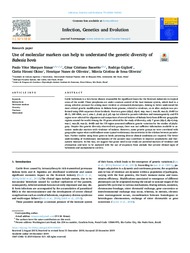Use of molecular markers can help to understand the genetic diversity of Babesia bovis.
Use of molecular markers can help to understand the genetic diversity of Babesia bovis.
Author(s): SIMAS, P. V. M; BASSETTO, C. C.; GIGLIOTI, R.; OKINO, C. H.; OLIVEIRA, H. N. de; OLIVEIRA, M. C. de S.
Summary: Cattle babesiosis is a tick-borne disease responsible for significant losses for the livestock industries in tropical areas of the world. These piroplasms are under constant control of the host immune system, which lead to a strong selective pressure for arising more virulent or attenuated phenotypes. Aiming to better understand the most critical genetic modifications in Babesia bovis genome, related to virulence, an in silico analysis was performed using DNA sequences from GenBank. Fourteen genes (sbp-2, sbp-4, trap, msa-1, msa-2b, msa-2c, Bv80 (or Bb-1), 18S rRNA, acs-1, ama-1, ?-tub, cp-2, p0, rap-1a) related to parasite infection and immunogenicity and ITS region were selected for alignment and comparison of several isolates of Babesia bovis from different geographic regions around the world. Among the 15 genes selected for the study of diversity, only 7 genes (sbp-2, sbp-4, trap, msa-1, msa-2b, msa-2c, Bv80) and the ITS region presented sufficient genetic variation for the studies of phylogeny. Despite this genetic diversity observed into groups, there was not sufficient information available to associate molecular markers with virulence of isolates. However, some genetic groups no were correlated with geographic region what could indicate some typical evolutionary characteristics in the relation between parasite-host. Further studies using these genes in herds presenting diverse clinical conditions are required. The better understanding of evolutionary mechanisms of the parasite may contribute to improve prophylactic and therapeutic measures. In this way, we suggest that genes used in our study are potential markers of virulence and attenuation and have to be analyzed with the use of sequences from animals that present clinical signs of babesiosis and asymptomatic carriers.
Publication year: 2020
Types of publication: Journal article
Keywords: Attenuation, Babesia Bovis, Genetic diversity, Molecular markers, Virulence
Observation
Some of Embrapa's publications are published as ePub files. To read them, use or download one of the following free software options to your computer or mobile device. Android: Google Play Books; IOS: iBooks; Windows and Linux: Calibre.
Access other publications
Access the Agricultural Research Database (BDPA) to consult Embrapa's full library collection and records.
Visit Embrapa Bookstore to purchase books and other publications sold by Embrapa.

